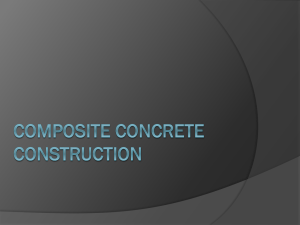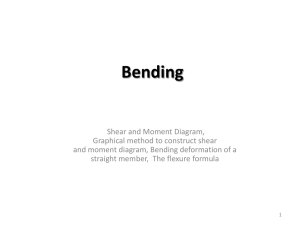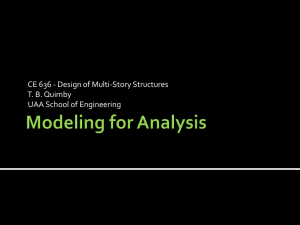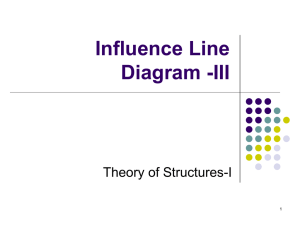Horizontal Shear Stress in Beams: Formula & Examples
advertisement
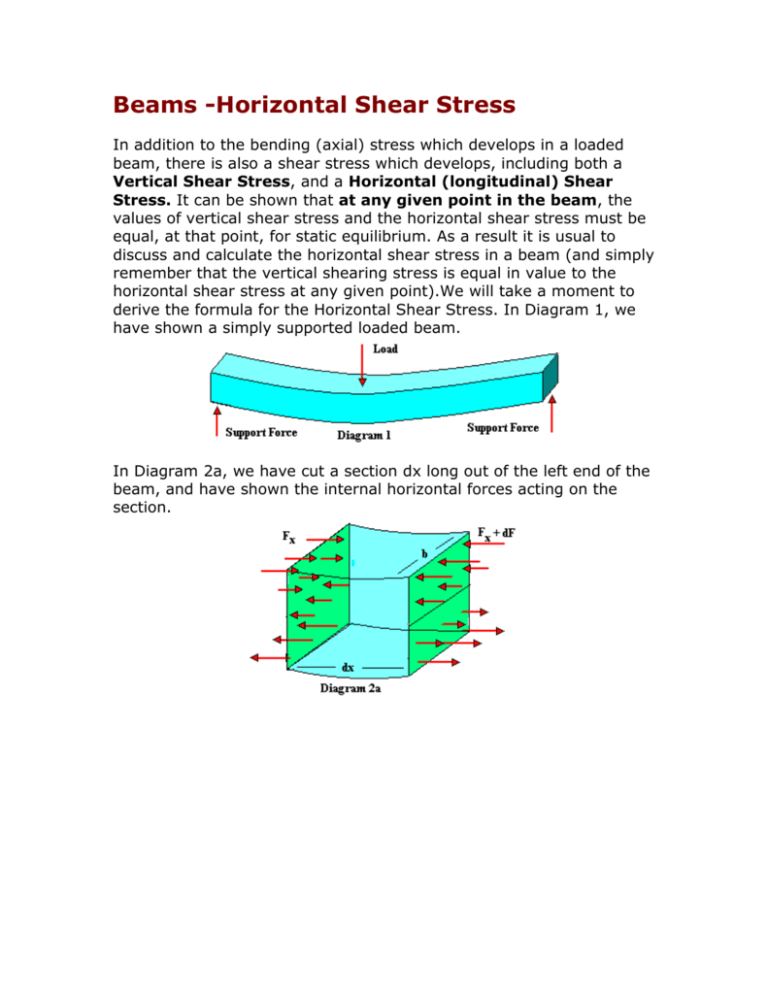
Beams -Horizontal Shear Stress In addition to the bending (axial) stress which develops in a loaded beam, there is also a shear stress which develops, including both a Vertical Shear Stress, and a Horizontal (longitudinal) Shear Stress. It can be shown that at any given point in the beam, the values of vertical shear stress and the horizontal shear stress must be equal, at that point, for static equilibrium. As a result it is usual to discuss and calculate the horizontal shear stress in a beam (and simply remember that the vertical shearing stress is equal in value to the horizontal shear stress at any given point).We will take a moment to derive the formula for the Horizontal Shear Stress. In Diagram 1, we have shown a simply supported loaded beam. In Diagram 2a, we have cut a section dx long out of the left end of the beam, and have shown the internal horizontal forces acting on the section. In Diagram 2b, we have shown a side view of section dx. Notice that the bending moment is larger on the right hand face of the section by an amount dM. (This is clear if we make the bending moment diagram for the beam, in which we see the bending moment increases from a value of zero at the left end to a maximum at the center of the beam.) In Diagram 2c, we have shown a top slice of section dx. Since the forces are different between the top of the section and the bottom of the section (less at the bottom) there is a differential (shearing) force which tries to shear the section, shown in Diagram 2c, horizontally. This means there is a shear stress on the section, and in terms of the shear stress, the differential shearing force, F, can be written as F = times the longitudinal area of the section (b dx). A second way of expressing the shear force is by expressing the forces in terms of the bending stress, that is F1 = (My/I) dA, and F2 = (M+dM)y/I dA, then the differential force is (dM y/I)dA. If we now combine the two F = expressions, we have: F= * b dx = (dM y/I)dA, and then rewriting to solve for the shear stress: = [(dM/dx)/Ib] y dA, however dM/dx is equal to the shear force V (as discussed in the previous topic), and y dA is the first moment of the area of the section, and may be written as A y', where A is the area of the section and y' is the distance from the centroid of the area A to the neutral axis of the beam cross section. Rewriting in a final form we have: Horizontal Shear Stress: = VAy'/Ib, where V = Shear force at location along the beam where we wish to find from the horizontal shear stress A = cross sectional area, from point where we wish to find the shear stress at, to an outer edge of the beam cross section (top or bottom) y' = distance from neutral axis to the centroid of the area A. I = moment of inertia for the beam cross section. b = width of the beam at the point we wish to determine the shear stress. (In some texts, the product Ay' is given the symbol Q and used in the shear stress equation) If we consider our shear relationship a little, we observe that the Horizontal Shear Stress is zero at the outer edge of the beam since the area A is zero there. The Horizontal Shear Stress is (normally) a maximum at the neutral axis of the beam. This is the opposite of the behavior of the Bending Stress which is maximum at the other edge of the beam, and zero at the neutral axis. To help clarify the Horizontal Shear Stress equation we will now look at at several example of calculating the Horizontal Shear Stress. Example 1 In Diagram 1, we have shown a simply supported 20 ft. beam with a load of 10,000 lb. acting downward at the center of the beam. The beam used is a rectangular 2" by 4" steel beam. We would like to determine the maximum Horizontal Shear Stress which develops in the beam due to the loading. We will also determine the Horizontal Shear Stress 3 inches above the bottom of the beam at the position in the beam where the shear force is a maximum. Step 1: Out first step in solving this problem is to apply static equilibrium conditions to determine the external support reactions. In this particular example, because of the symmetry of the problem, we will not go through the statics in detail, but point out that the two support forces will support the load at the center equally with forces of 5000 lb. each as shown in Diagram 2. Step 2: The second step is to draw the shear force and bending moment diagrams for the beam. Step 3. We will now apply the Horizontal Shear Stress formula: Shear Stress = Vay'/Ib We wish to find the maximum shear stress, which occurs at the neutral axis of the beam: V = maximum shear force = 5,000 ft-lb. (from the shear force diagram) I = moment of inertia of cross section; for rectangle I = (1/12) bd3 = 1/12 (2" * 4"3) = 10.67 in4. b = width of beam section where we wish to find shear stress at; b= 2 in. a = area from point we wish to find shear stress at (neutral axis) to an outer edge of beam a= (2" x 2")= 4 in2. y' = distance from neutral axis to the centroid of the area "a" which we used; y'= 1 in. (See Diagram 4) Placing the values into the equation, we find: Maximum Horizontal Shear Stress = Vay'/Ib = (5000 lb)*(4 in2)*(1 in)/ (10.67 in4)(2 in)= 937 lb/in2 Part II We now would also like to determine the Horizontal Shear Stress 3 inches above the bottom of the beam at the position in the beam where the shear force is a maximum (which is actually through out the beam, since the value of shear force is either +5000 lb., or 5000 lb. through out the beam.) We again apply the Horizontal Shear Stress formula: Horizontal Shear Stress = Vay'/Ib We wish to find the shear stress 3 inches above the bottom of the beam cross section. (See Diagram 5) V = shear force = 5,000 ft-lb. (from the shear force diagram) I = moment of inertia of cross section; for rectangle I = (1/12) bd3 = 1/12 (2" * 4"3) = 10.67 in4. b = width of beam section where we wish to find shear stress at; b = 2 in. a = area from point we wish to find shear stress at (3" above bottom of the beam) to an outer edge of beam. We will go to the top edge of the beam, then a = (2" x 1")= 2 in2. y' = distance from neutral axis to the centroid of the area "a" which we used; y'= 1.5 in. (See Diagram 5) Then the horizontal shear stress 3 inches above the bottom of the beam is: Horizontal Shear Stress = Vay'/Ib = (5000 lb)*(2 in2)*(1.5 in)/ (10.67 in4)(2 in)= 703 lb/in2 Notice, as we expect, the horizontal shear stress value becomes smaller as we move toward the outer edge of the beam cross section. Horizontal Shear Stress - Example 2 A loaded, simply supported beam is shown in Diagram 1. For two different beam cross sections (a WT 8 x 25 T-beam, and a W 10 x 45 beam) we will determine the maximum Horizontal Shear Stress which would develop in the beam due to the loading. We will also determine the Horizontal Shear Stress 3 inches above the bottom of the beam at the position in the beam where the shear force is a maximum. STEP 1: Apply Static Equilibrium Principles and determine the external support reactions: 1.) FBD of structure (See Diagram 2) 2.) Resolve all forces into x/y components 3.) Apply equilibrium conditions: Sum Fx = 0 none Sum Fy = By + Cy - 1,000 lbs/ft (4 ft) - 1,500 lbs/ft (4 ft) = 0 Sum TB = 1,000 lbs/ft (4 ft) (2 ft) - 1,500 lbs/ft (4 ft) (8 ft) + Cy(6 ft) = 0 Solving: By = 3,330 lb.; Cy = 6,670 lb. Step 2: The second step is to draw the shear force and bending moment diagrams for the beam Beam Table for WT 8 x 25 Designation Area of T Width thick thick - x-x axis x-x axis x-x axis x-x axis - A d bf tf tw d/tw I S r y - in2 in in in in - in4 in3 in in WT 8x25 7.36 8.13 7.073 0.628 0.380 21.40 42.20 6.770 2.400 1.890 Step 3. For the WT 8 x 25 T-beam (table above) we will now apply the Horizontal Shear Stress formula: Shear Stress = Vay'/Ib, to find the maximum shear stress, which occurs at the neutral axis of the beam: V = maximum shear force = 6,000 lb. (from the shear force diagram) I = moment of inertia of cross section, from beam table; I = 42.20 in4. b = width of beam where we wish to find shear stress (neutral axis for maximum) from table; b = .38 in. a = area from point we wish to find shear stress at (neutral axis) to an outer edge of beam. In this case we will go to bottom of beam. Then a = (.38" * 6.24" )= 2.37 in2. y' = distance from neutral axis to the centroid of the area "a" ; y' = 3.12 in. (See Diagram 5) Then placing values into our expression we find: Maximum Horizontal Shear Stress = Vay'/Ib = (6000 lb)*(2.37 in2)*(3.12 in)/ (42.20 in4)(.38 in) = 2770 lb/in2 We now would also like to determine the Horizontal Shear Stress 3 inches above the bottom of the beam at the position in the beam where the shear force is a maximum We again apply the Horizontal Shear Stress formula: Shear Stress = Vay'/Ib We wish to find the shear stress 3 inches above the bottom of the beam cross section, where the shear force is a maximum. (See Diagram 6)\ V = maximum shear force = 6,000 lb. (from the shear force diagram) I = moment of inertia of cross section, from beam table; I = 42.20 in4. b = width of beam where we wish to find shear stress (3" above bottom of beam) from table; b = .38 in. a = area from point we wish to find shear stress at (neutral axis) to an outer edge of beam. In this case we will go to bottom of beam. Then a = (.38" * 3" )= 1.14 in2. (See Diagram 6) y' = distance from neutral axis to the centroid of the area "a" ; y' = 4.74 in. (See Diagram 6) Then the horizontal shear stress 3 inches above the bottom of the beam is: Horizontal Shear Stress = Vay'/Ib = (6000 lb)*(1.14 in2)*(4.74 in)/ (42.2 in4)(.38 in)= 2020 lb/in2 Notice, as we expect, the horizontal shear stress value becomes smaller as we move toward an outer edge of the beam cross section. Part 2: W 10 x 45 beam: We would like to again determine the maximum horizontal shear stress, and the shear stress 3 inches above the bottom of the beam (at the point where the shear force is a maximum), but now find these values for a W 10 x 45 I-beam. Beam Table for W 10 x 45 I-Beam - - - Flange Flange Web Designation Area Depth Width Cross Section Info. Cross Section Info. thick thick x-x axis x-x axis x-x axis y-y axis y-y axis y-y axis - A d bf tf tw I S r I S r - in2 in in in in in4 in3 in in4 in3 in 13.30 2.00 W 10 x 45 13.20 10.12 8.022 0.618 0.350 249.0 49.1 4.33 53.20 We have already done the statics, and the shear force and bending moment diagrams are shown in the first part of this example above, so we continue at the point where we apply the horizontal shear stress formula to find the values we desire. For the WT 8 x 25 T-beam we apply the Horizontal Shear Stress formula: Shear Stress = Vay'/Ib, however since we are looking for the maximum shear stress in the I-Beam, we can use the approximate formula for I-beam, Maximum Horizontal Shear Stress = Vmax/Aweb. This says the approximate maximum shear stress in an I - Beam is equal to the maximum shear force divided by the area of the web of the I-Beam. Applying this we have: Vmax = maximum shear force = 6,000 lb. (from the shear force diagram) Amax = area of web: A = (.35" * 8.88" )= 3.11 in2. (See Diagram 7) Then Maximum Horizontal Shear Stress = (6000 lb)/(3.11 in2) = 1930 lb/in2 As long as this approximate value is reasonably below the allowable shear stress for the beam material there is no need to use the exact formula for the maximum shear stress. Please remember, however, the approximate formula is only for the maximum horizontal shear stress (which occurs are the neutral axis) in an I-Beam. If we need to know the shear stress at any other location, we must use the standard formula – as we will do in the next part. We now wish to find the shear stress 3 inches above the bottom of the beam cross section, where the shear force is a maximum. (See Diagram 8). To do so, we apply the standard horizontal shear stress formula: Shear Stress = Vay'/Ib V = maximum shear force = 6,000 lb. (from the shear force diagram) I = moment of inertia of cross section, from beam table; I = 249.0 in4. b = width of beam where we wish to find shear stress (3" above bottom of beam) from table; b = .35 in. a = area from point we wish to find shear stress at (3" from the bottom) to an outer edge of beam. In this case we will go to bottom of beam. Notice that the area is composed of the area of the flange (A1) and part of the area of the web (A2). (See Diagrams 8 and 9.) Then a = (A1 + A2)= (.618" x 8.022") + (2.383 in2 x .35in2) = 4.96 in2 + .834 in2= 5.794 in2 (See Diagram 9) y' = distance from neutral axis to the centroid of the area "a" Notice that in this case, for an I-Beam, this is not a entirely simple matter. The area we wish to find the centroid of is not a simple rectangle, but rather two rectangles. To find the centroid of this compound area we use: y' = (A1 y1 + A2 y2)/(A1 +A2); where A1 and A2 are the two areas, and y1 and y2 are the distances from the neutral axis of the beam to the centroid of each of the respective areas. (Which is simply the distance from the neutral axis to the center of each of the respective areas, since for a rectangle the centroid is at the center.) Using the values shown in Diagram 9, we have: y' = (A1 y1 + A2 y2)/(A1 +A2) = (4.96 in2 x 4.75 in + .834 in2 x 2.94 in)/(4.96 in2 + .834 in2) = 4.49 in. Then the horizontal shear stress 3 inches above the bottom of the beam is: Horizontal Shear Stress = Vay'/Ib = (6000 lb)*(5.794 in2)*(4.49 in)/ (249.0 in4)(.35 in)= 1790 lb/in2 Notice, as we expect, the horizontal shear stress value becomes smaller as we move toward an outer edge of the beam cross section.

